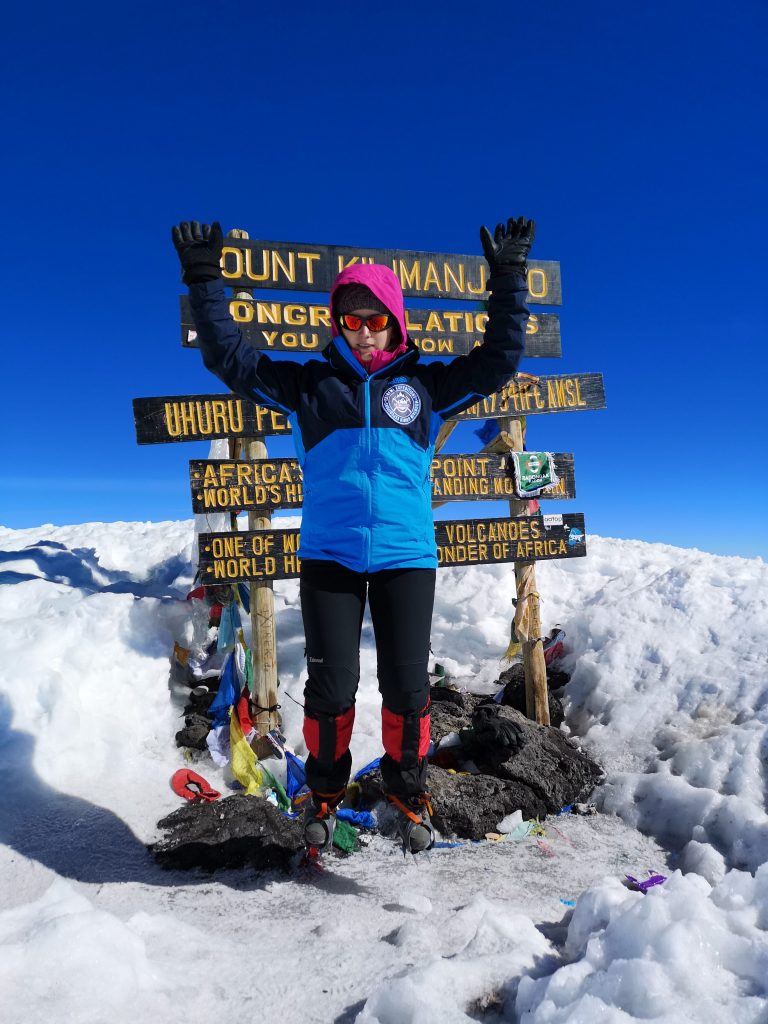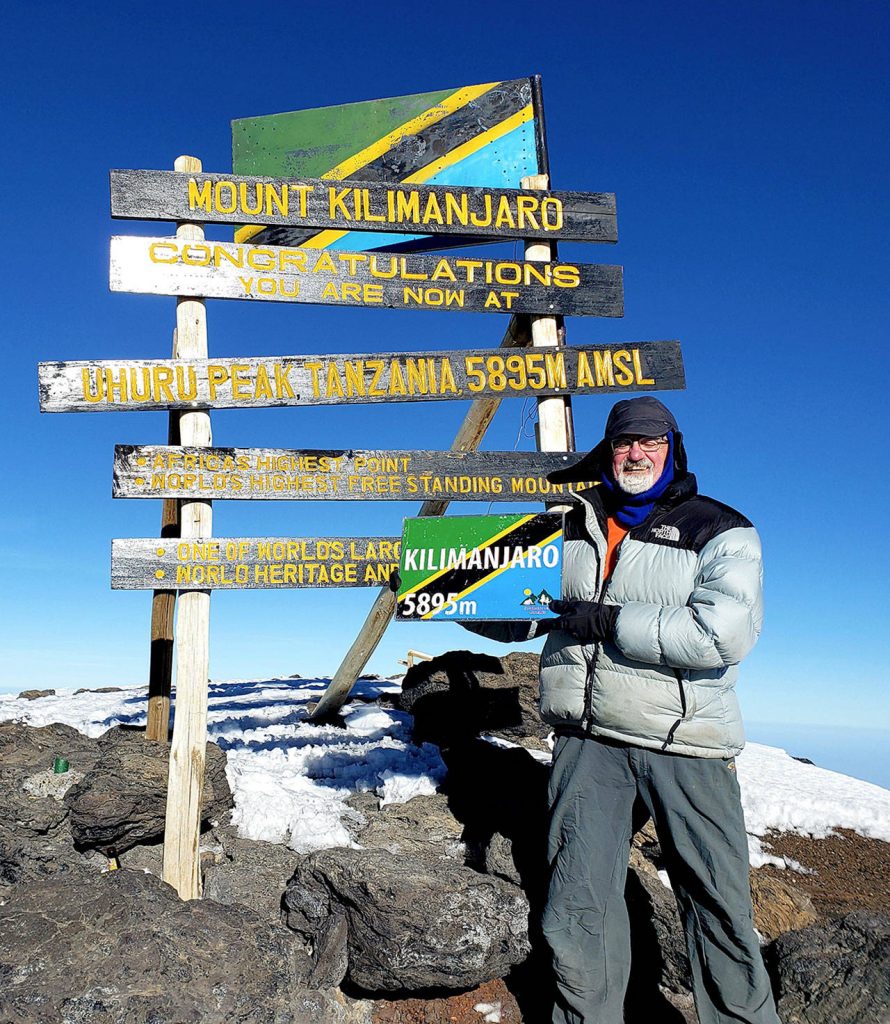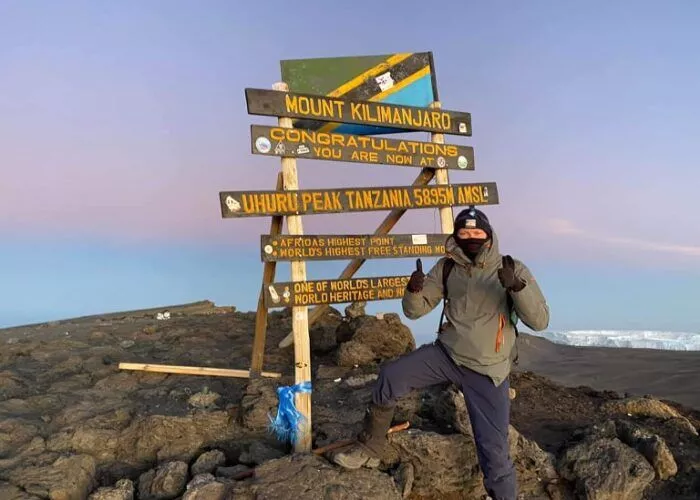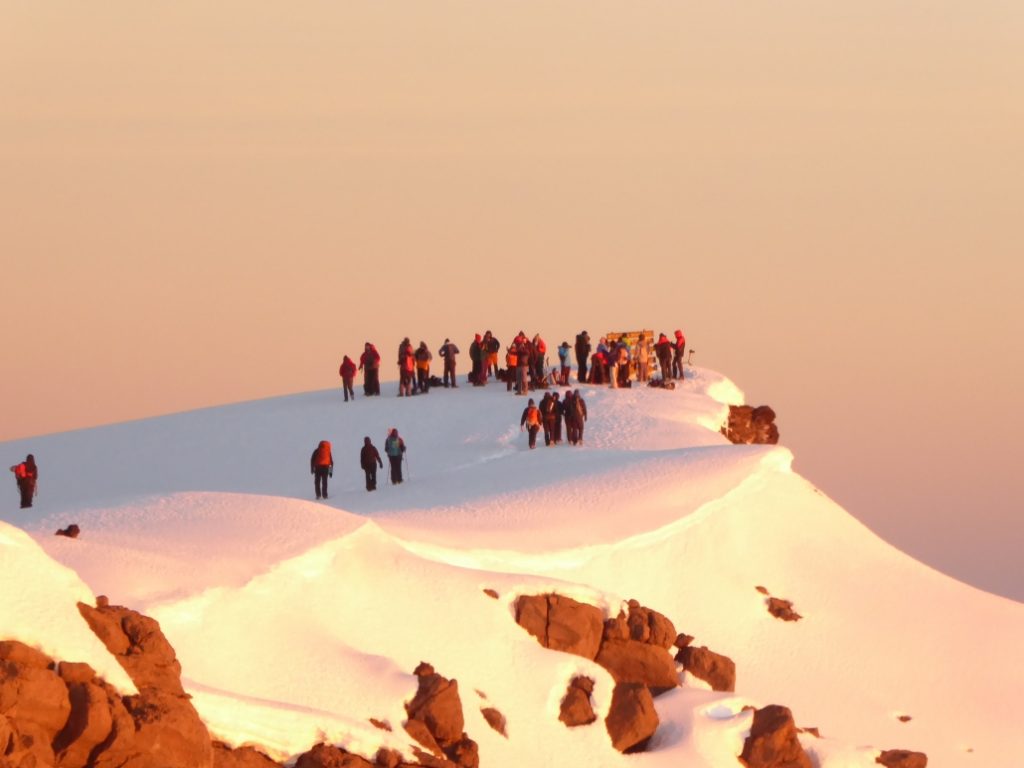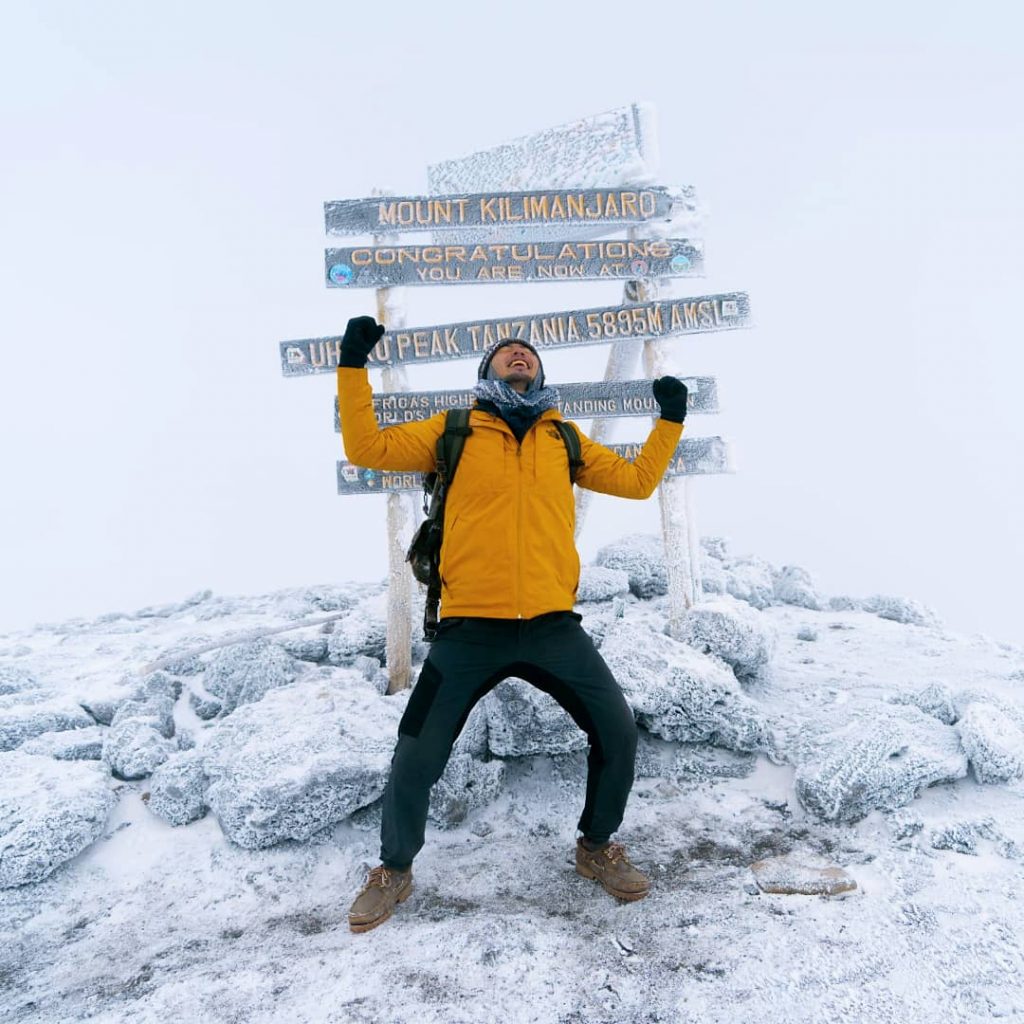Kilimanjaro is high and is susceptible to the effects of altitude, which sometimes can be fatal. This can be seen as a disadvantage in relation to other mountains since it is a risk and it is difficult to acclimatize. This is what draws people to Kilimanjaro, being challenging and being at the risk limit for the average person on vacation. Being a non-technical summit, it appeals to all who have that yearn for something different, something extravagant to boast to friends about. The highest success rate comes from ample preparation and good guide service. This is an encouraging factor to most would-be Kili adventurers who are a mix of age and fitness.
First and foremost, before any mountainous journey, comes a well-thought-out plan. This, in itself, creates a psychological feeling that an adventure has begun. The very idea of planning to scale a mountain recreates a sense of disconnection from the daily norm of things. Usually, camping out on a mountainside brings a sense of sake and adventure, and with Kilimanjaro, most routes provide this. With the added advantage of animal life and breathtaking scenery, it makes a change from the usual alpine trek in Europe. The cost of flights and the mountain’s proximity to the equator has made this an attractive adventure despite relatively expensive National Park fees set by the Tanzanian Government.
Ranked as one of the most sought-after trekking and climbing destinations, the highest mountain in Africa has a lot to offer for its adventurers. Mount Kilimanjaro is Africa’s highest peak and the world’s highest freestanding mountain (approximately 5,895 meters). Towering from the surrounding coastal shrubland, an elevation change of up to 5 km over a short distance of only 50 km means that the mountain’s sides are steep. It has been a popular attraction for the old and the young to attempt the summit. Kilimanjaro has definitely got to be on the list of anyone seeking a mountainous adventure.
The Machame route has become the most popular route in recent years. It is considered a difficult route, and trekkers should be in good hiking shape. The route approaches from the southwest and descends using Mweka, the same way climbers using the Lemosho route or Shira route would. An assessment to survey the difficulty and success rates on the Machame route would be a high 4 to a 5. The Lemosho route is similar to the Machame route, but it is a newer route and it approaches from the western side of the mountain. On average, it takes 7 or more days to attempt either the Lemosho or Machame route. Success rates are similar for both routes and above the average for all climbers on the mountain.
Based on the general consensus from our client base, those who have embarked on various routes to reach Uhuru peak at the summit of Mt. Kilimanjaro have found all routes to be both challenging and rewarding. However, each route has its own unique characteristics and difficulty level. For instance, the Marangu route is considered the easiest route, but only 35% of clients on 5-day routes and 45% on 6-day routes reach Uhuru peak. The Rongai route is also relatively simple, though it is flatter than the Marangu route and has the added bonus of being less crowded. This route is considered to be one of the easiest routes up the mountain.
Among the six routes up Mount Kilimanjaro, the Machame route is the most demanding of your physical condition and the most rewarding for that effort. Firstly, the ‘Whiskey’ route is for the true adventurer – it is the most demanding but by far the most successful and the absolute best for acclimatization. The ‘Whiskey’ route is only for the strong. It is the only route up Kilimanjaro offering real technical climbing and with rock, ice, and large areas of scree – thus the name. Emily N’s review takes a look at her personal experience on the Machame route. Whilst all the effort expended on the climb will be worthwhile once you reach the summit, the Machame route is known for its steep and stony sections and regularly crossing the valleys and ridges of the mountain on rough terrain. These conditions may make it slightly uncomfortable for those unaccustomed to trekking or walking, as Emily points out about her trek. However, the challenge that trekking the Machame route presents is an advantageous one. The days are long and tough, but you will feel a real sense of accomplishment each time you reach camp having conquered the day’s trek and will be even more satisfied come the end of the climb. Emily also makes an interesting observation that the route is less crowded in comparison to the others, despite the fact that it has gained popularity over the years. Especially with the majority of climbers aiming to reach the summit for sunrise on the last day, the Machame route will give a sense of being a true expedition into the unknown. Despite this, however, given its greater amount of vegetation and longer periods spent at lower altitudes, the route has a higher chance of successful acclimatization and thus a higher success rate of reaching the summit. Higher Success Rates are often attributed as the best route for acclimatization due to its trek high trek down approach.
We knew we would finally get to see the mountain on the third day, after crossing the saddle, and as we woke there was Kibo. The familiar cone we had seen only on beer bottles loomed above in the early morning light. We left Barranco and continued on a path that scaled the steep, impressive Great Barranco Wall. Then the remainder of the day was spent skirting the base of Kibo, finally stopping at our campsite, Kibo Hut. We would spend two nights here, acclimatizing. The day’s trek took about seven hours and was a great day: some good rock scrambling, great views, and close proximity to our objective, Kibo, and the mountain. The next day was a long trek across the massive saddle between Mawenzi and Kibo. The Western Breach route offers a spectacular view of the summit from the distance. The day ended at the beautifully located campsite called School Hut. All around the stunning views of Kibo and Mawenzi were ours to enjoy.
Guides and support provided during my climb with Tranquil Kilimanjaro were excellent. Our guides were Hamisi and Elias. A purposeful first meeting in the hotel gardens set the scene. They were very knowledgeable and personable, and this contributed greatly to the cohesiveness of the group. Daily briefings ensured that we were all prepared for what lay ahead, mentally as well as physically. It also provided a forum for open discussion about the pace, structure, and the flexibility displayed by the guides in this respect was invaluable. Their knowledge of the flora and fauna added another dimension to the trip and was something we all found interesting. This section of the trip culminated with the overnight ascent to the crater rim and the high altitude snows. Hamisi and Elias showed great fortitude in some pretty extreme conditions in order to get the entire group to the top of Kilimanjaro. A couple of our party suffered minor snow injuries as a result of this and the high camp before, and this was compassionately dealt with and the support provided allowed for the best possible recovery. Our descent was rapid and again flexible, allowing for those who were feeling good to stretch their legs while others took it a bit slower.
Guides are the most significant factor in your enjoyment of the climb and your safety. Climbing Kilimanjaro using our services is an assurance of our high standard of guides. All our guides have been educated at Mweka Wildlife College in Moshi, Tanzania. The college is the only one of its kind in Tanzania and offers 2-year courses in 3 disciplines: Field botany/ Zoology, Mountain Ecology, and Wildlife Tourism. The college produces the majority of the assistant guides and guides who climb Kilimanjaro and work on safari in Tanzania. Their training is evident on the mountain and in their interaction with clients. Our guides are able to tailor information about the mountain to the education level of the client. This includes anything from basic flora and fauna to the intricate details of the habits of the endemic animals on the mountain. The guides are also able to relate to the client in their own shared experiences in nature and have common interests in preserving the environment for future generations. All of our guides are fluent in English and are competent in medical instruction and first aid, having attended first aid courses approved by Wilderness Medicine. All of the courses have been taught by a lead instructor who is an American Medical Association certified Physician’s Assistant.
Receiving excellent team support will make a significant difference to enjoying your time on Kilimanjaro. In fact, the level of service provided by the support staff often determines whether or not a client successfully reaches the summit. Throughout the trek, you may hear Tanzanians using the Swahili word ‘safari’, which translates as ‘journey’. Every successful journey is much sweeter with a little help, and that is exactly what you can expect from our team. You will be guided by professional, experienced mountain guides who have climbed the mountain many times. A ratio of 1 guide to 2 clients is adhered to on the 6 and 7-day Machame and Rongai Routes, costing you nothing extra. This is to ensure that should someone in your party feel unwell or be too slow to make the summit, they can be escorted down to the lower slopes without affecting the other team members’ chances. If you are booking a private climb on any route, then you can choose your preferred ratio of guides to clients. Your guides will ensure that every day of your journey is as enjoyable as possible, providing entertainment and ‘Pole Pole’ (slowly slowly) reminders when necessary. They will use their medical training to monitor your health at all times and have the authority to decide whether or not you are to continue with the ascent. If they believe it is not in your best interests to continue, they will escort you to the safest point on the mountain and assist you in descending. On reaching the summit, the guides will take your photograph as a treasured memory of your achievement and will, of course, point out the famous signpost. At the higher camps, our support staff will include porters and a cook. Porters will have usually carried your bag up to this point and will be setting up camp upon your arrival. You may be surprised to witness them running past you up the trail (It’s true! They will always beat you to the next destination!) with their 20kg load balanced upon their head by just a strap of an old car tire! These are some tough cookies, and their singing and general positive demeanour will be one of the highlights of your trip. The Kilimanjaro Porter’s Assistance Association ensures that all porters are properly clothed and that their load is not too heavy – thus you need only carry your daypack during the trek. Your cook will work wonders at 4600m using only a gas stove and create delicious and wholesome meals to replenish your energy.
Before the trek begins, briefings will be given, highlighting the use of the equipment provided and any safety concerns that should be considered. Each of our porters will be carrying a full first aid kit and oxygen for emergency purposes. Safety is very important. Although a difficult decision, retreat is always an option if somebody is not feeling well. Descent can be rapid if required, and clients will be safely transported back to the hotel. Our guides have been trained in wilderness first aid and can handle the basic medical issues that could be encountered on a trip. In more serious cases, our guides are in constant radio communication with the base and in touch with the Flying Doctors Service who can provide an evacuation to a hospital. In the rare event of an emergency occurring on the mountain, our local contacts and Kilimanjaro Search and Rescue (SAR) can provide a rapid and efficient rescue service.
Overall, the feedback at the end of each safari was that our clients hadn’t expected to be as comfortable on the mountain. This is a great compliment for it was never our intention to understate aspects of the climb and give false impressions on a ‘holiday trek’, but rather guide and lead our clients through a safe and enjoyable experience on their journey to the top of Africa.
The most important part of the review was that obviously the higher you climb, the greater the decline in facilities. However, we strive to maintain the same standards of comfort and cleanliness at all camps. This was proven on the trek with the general satisfaction in the meals provided, where a good variety of food is dished up. Favourite base camp meals included beef stew, pasta dishes, and some tasty soups. On summit night, clients were very happy with the light meal and hot drink provided. But it is the facilities in relative comparison that impressed many of our clients. Tents are always pitched in secluded areas where possible, and the toilet tents are regularly maintained with sanitary conditions and toilet paper! There were many pleasant surprises for the ladies who expected the worst and were all very thankful for our detailing in provision and feminine hygiene products. This is an area we will always take extra porter support, as maintaining good facilities makes a big difference for the crew and avoidance of the campsite.
Highlights of the reviews were comfort at the camps and having reliable and hygienic facilities. Over 95% of our clients commented on how effective the service delivery was considering the logistical difficulties on the mountain. There are 3 base camps of comfort to consider: Shira, Barranco, and Karanga. At the first 2 camps, spacious 2-person tents are provided for every 1-person climber. This is very helpful in preventing single travellers from feeling isolated from the group. At Barafu camp, we will always request single-person climbers to share a tent with a member of the crew for security reasons. All the mountain camps provide a dining mess tent with a table and chairs. This is very important as after a long day of trekking and ascending in sometimes tough weather conditions, it is nice to relax and enjoy summit and dinner meals in a comfortable setting. Server sleeping mattresses are also an added bonus compared to the standard-issue mattresses provided by the park authorities.
A base camp where climbers can relax at the end of a hard day’s walk is important. The camps should be designed so the climbers don’t have any problems if it rains. At all the base camps on Kilimanjaro, there are huts provided by the national park. These are communal and can get very smoky and stuffy. Private organizations and trekking companies have also set up their own tents for dining and socializing, and some have their own toilets. Most trekkers going up Kilimanjaro use the Marangu route as it is the cheapest and the only route where you don’t have to camp. Unfortunately, the Marangu route can be rather overcrowded and the accommodation is nowhere near as good as in the private campsites which we use on the other route. It is, however, the only route where altitude is gained gradually (too gradually for it to be very good for acclimatization) and in fact, too comfortable an ascent for some as it is the route with the lowest success rate.
During the climb, the hikers will be dining on three meals a day, with hot drinks at breakfast and soups at dinner. The food is of good quality and more than enough to go around. While most hikers find that the food is one of the highlights of the trek, others with special dietary requirements are not left dissatisfied. A special menu for vegetarians or halal can be arranged. All water is boiled or purified with purification tablets. This represents an eco-friendly solution to the disposable bottled water sold on the lower slopes, which could have a negative environmental impact in the long term. Please inform us of any special dietary requirements before departure.
Before going on the safari, make sure that all equipment and clothing is packed into a soft duffle bag, weighing a maximum of 15kg, including your sleeping bag. A sleeping bag is required.
Unveiling the Enchantment: Mount Kilimanjaro Reviews
The allure of Mount Kilimanjaro’s majestic peak has drawn adventurers and nature enthusiasts from across the globe. With its towering presence and diverse landscapes, Kilimanjaro offers an unforgettable experience that has left a lasting impact on those who have dared to conquer its heights. Let’s delve into the reviews of those who have ventured up this iconic African mountain.
Awe-Inspiring Views That Take Your Breath Away
Review after review echoes the sentiment of being spellbound by the breathtaking vistas encountered during the ascent. The ever-changing landscapes, from lush rainforests to alpine deserts and glaciated slopes, create a sense of wonder with every step. Many climbers express that the reward of reaching the summit and witnessing the sun rise above the clouds is an unparalleled experience that etches itself into memory forever.
A Journey of Personal Triumph
Mount Kilimanjaro is not merely a physical challenge; it’s a journey of self-discovery and triumph. Climbers often recount the emotional and mental growth they undergo throughout the climb. The resilience and determination required to face altitude-related hurdles inspire a newfound sense of accomplishment and confidence. Reviews often emphasize that the journey is as much about conquering oneself as it is about conquering the mountain.
Guided by Expertise and Support
Guides and porters play an integral role in the Kilimanjaro experience, and reviews consistently highlight their exceptional dedication. Many climbers express gratitude for the expertise, encouragement, and support provided by these individuals. The warmth and camaraderie shared with the team elevate the climb from an expedition to a shared adventure, fostering a sense of unity and friendship.
A Glimpse into Tanzanian Culture
Beyond the physical challenge and scenic beauty, climbers often appreciate the opportunity to immerse themselves in Tanzanian culture. Interacting with locals, experiencing traditional customs, and learning about the region’s history enrich the journey. Reviews frequently mention the hospitality of the Tanzanian people, creating a cultural connection that lingers long after the climb.
The Unforgettable Summit
Reaching Uhuru Peak, the highest point of Kilimanjaro, is a moment of triumph that leaves climbers in awe of their own capabilities. Reviews are replete with accounts of tears of joy, celebratory shouts, and a sense of achievement that can hardly be put into words. The summit represents not just the culmination of physical effort, but also the realization of a dream.
The Sum of its Parts
In the tapestry of Mount Kilimanjaro reviews, a common thread emerges: the climb is more than a physical feat; it’s an exploration of nature’s beauty, an introspective journey, a cultural immersion, and a triumph of the human spirit. Whether it’s the camaraderie with fellow climbers, the sense of accomplishment, or the connection to the natural world, Kilimanjaro leaves an indelible mark on the hearts and minds of those who seek its summit.
Kilimanjaro Reviews and Testimonials: A Glimpse into the Journey
The allure of Mount Kilimanjaro transcends its towering heights; it’s a journey of self-discovery, triumph, and connection to nature. Reviews and testimonials from those who have embarked on this iconic African expedition provide a window into the transformative experience that awaits climbers.
Personal Triumphs Amidst Nature’s Grandeur
Across the spectrum of reviews, a unanimous sentiment prevails: Kilimanjaro’s landscapes and vistas are awe-inspiring. Climbers often describe the emotional impact of witnessing the sunrise above the clouds from the summit. The journey through diverse terrains, from lush rainforests to arid alpine deserts, creates a deep sense of wonder and appreciation for the natural world.
Conquering Challenges and Discovering Strength
Kilimanjaro isn’t just a physical ascent; it’s a path of mental and emotional growth. Reviews frequently highlight the challenges posed by altitude and the perseverance required to overcome them. Climbers emerge from the experience with a renewed sense of self-belief, having conquered not only the mountain but also personal doubts and limitations.
Guiding Lights: The Role of Local Expertise
Guides and porters are the unsung heroes of the Kilimanjaro climb, as noted in numerous testimonials. Their knowledge, encouragement, and camaraderie play a pivotal role in the journey’s success. Many reviews emphasize the genuine connections formed with the local team, turning the climb into a shared adventure marked by mutual support and friendship.
Cultural Immersion and Hospitality
The Kilimanjaro experience extends beyond its physical challenges; it offers a window into Tanzanian culture. Interactions with local communities, exposure to traditional customs, and learning about the region’s history enrich the journey. Reviews often recount the warmth and hospitality of the Tanzanian people, creating lasting cultural connections.
The Pinnacle of Achievement: Uhuru Peak
Reaching Uhuru Peak is a transformative moment that reverberates through reviews and testimonials. Climbers describe the overwhelming emotions of joy, accomplishment, and even tears upon conquering the summit. The shared triumph with fellow climbers and the sense of standing atop Africa create memories that endure far beyond the climb.
A Tapestry of Experiences
Within the mosaic of Kilimanjaro reviews and testimonials, a common thread emerges: the climb is a multifaceted adventure. It’s a celebration of nature’s beauty, an exploration of personal boundaries, an embrace of local culture, and a triumph of the human spirit. Whether it’s the euphoria of reaching the summit, the bonds formed with fellow climbers, or the immersion in a new environment, Kilimanjaro leaves an indelible mark on every climber’s journey.
If these reviews have sparked your curiosity, learn more about embarking on your own Kilimanjaro adventure at [email protected]
The Significance of Reviews: Why They Matter More Than You Think
In the age of digital connectivity, reviews have emerged as a powerful tool that influences our choices, decisions, and perceptions. From choosing a restaurant for dinner to planning an adventurous journey, the importance of reviews cannot be overstated. Let’s delve into why reviews matter more than you might realize.
1. Authenticity and Transparency
Reviews provide authentic insights into products, services, and experiences. They come from real people who have interacted with a business or engaged in an activity. This transparency allows potential consumers to access unfiltered opinions and make informed choices. In a world inundated with marketing messages, reviews offer a genuine perspective that cuts through the noise.
2. Building Trust
Trust is the cornerstone of any successful relationship, whether it’s between a business and its customers or a traveler and a destination. Positive reviews build trust by validating the claims made by a business. They showcase real-life instances of customer satisfaction and demonstrate that promises are being fulfilled. Moreover, a mix of positive and constructive reviews fosters credibility, as it portrays a balanced picture of the offering.
3. Peer Recommendations
Humans are naturally inclined to seek advice and recommendations from peers. Reviews act as virtual word-of-mouth, replicating the personal recommendations we seek from friends and family. When potential customers see that others have had positive experiences, they’re more likely to engage with a product or service. This peer validation adds a layer of reliability to decision-making.
4. Insightful Decision-Making
Whether it’s a mundane purchase or a life-changing adventure, reviews help us make better decisions. They provide insights into the pros and cons of a product or service, allowing us to weigh our options objectively. Reviews often highlight aspects that might not be apparent from a business’s promotional content, helping us avoid potential pitfalls.
5. Enhancing Experiences
Reviews play a pivotal role in enhancing customer experiences. Negative reviews offer businesses an opportunity to identify areas of improvement and rectify shortcomings. This feedback loop fosters a culture of continuous enhancement, ultimately benefiting future customers. Positive reviews, on the other hand, reinforce the value of a service, motivating businesses to maintain high standards.
6. Empowerment of Consumers
Reviews empower consumers by giving them a voice. They provide an avenue for customers to express their opinions and share their experiences, creating a sense of agency. When consumers feel heard and valued, it strengthens their connection to a brand or service provider.
7. Constructive Feedback Loop
For businesses, reviews serve as a constructive feedback loop. They offer valuable insights into customer preferences, pain points, and expectations. This information can inform strategic decisions, product development, and customer service improvements. In essence, reviews bridge the gap between businesses and their target audience, fostering a symbiotic relationship.
Tranquil Kilimanjaro Reviews
In an era defined by information abundance, Tranquil Kilimanjaro reviews emerge as guiding lights amidst the clutter. They aid in decision-making, foster trust, and facilitate meaningful connections between consumers and businesses. Whether you’re planning a vacation, exploring a new restaurant, or considering a purchase, embracing the power of reviews is a step toward making well-informed choices.
Discovering Mount Kilimanjaro Through TripAdvisor Reviews
When it comes to seeking authentic insights and firsthand experiences, TripAdvisor reviews stand as a valuable testament to the allure of Mount Kilimanjaro. Let’s delve into the world of Mount Kilimanjaro TripAdvisor reviews to uncover the captivating narratives of those who have ventured to Africa’s highest peak.
1. Awe-Inspiring Landscapes That Leave a Mark
TripAdvisor reviews for Mount Kilimanjaro consistently highlight the captivating beauty of the landscapes. Climbers recount their awe at the ever-changing scenery, from dense rainforests teeming with life to barren alpine deserts resembling lunar landscapes. The journey itself becomes a visual feast, punctuated by moments of wonder that only nature can provide.
2. Triumphs of the Human Spirit
Beyond the physical challenge, TripAdvisor reviews showcase the emotional and mental triumphs that climbers experience. Many reviewers speak of pushing their boundaries, facing altitude-related obstacles, and emerging stronger. The climb becomes a journey of self-discovery, perseverance, and newfound confidence that extends beyond the summit.
3. Guides and Porters: Unsung Heroes
TripAdvisor reviews consistently acknowledge the invaluable role of guides and porters in the Kilimanjaro expedition. Climbers express gratitude for their unwavering support, expertise, and camaraderie. The relationships formed with the local team enrich the climb, turning it into a shared adventure marked by mutual encouragement and lasting connections.
4. Cultural Immersion and Warmth
Reviews often highlight the cultural immersion that Kilimanjaro offers. Interactions with local communities, exposure to traditional customs, and learning about Tanzanian heritage enrich the experience. Climbers frequently share anecdotes of the warmth and hospitality of the Tanzanian people, leaving a lasting cultural connection.
5. The Culmination of Triumph: Uhuru Peak
Reaching Uhuru Peak, the summit of Kilimanjaro with Tranquil Kilimanjaro emerges as a pivotal moment in TripAdvisor reviews. Climbers recount the elation, tears, and overwhelming sense of accomplishment that accompanies this triumph. The shared joy with fellow climbers and the breathtaking panoramic views create memories that linger long after the descent.
6. Insights for Future Explorers
TripAdvisor reviews offer invaluable insights for future climbers. They provide practical advice, tips, and considerations that can enhance the overall experience. From recommendations about packing essentials to guidance on route choices, these reviews serve as a roadmap for those planning their Kilimanjaro adventure.
7. The Heartfelt Connection
Amidst the diversity of experiences, a common thread runs through TripAdvisor reviews: the profound impact of Mount Kilimanjaro on the human heart. Whether it’s the sense of accomplishment, the bond with nature, the connections with local communities, or the camaraderie with fellow climbers, Kilimanjaro leaves an indelible mark on every individual’s journey.
Unveil the Magic Yourself
As you peruse TripAdvisor reviews of Mount Kilimanjaro by Tranquil Kilimanjaro, you’ll find a tapestry of emotions, triumphs, and connections that form the essence of this extraordinary expedition. If these reviews have ignited your curiosity, delve deeper into planning your own Kilimanjaro





